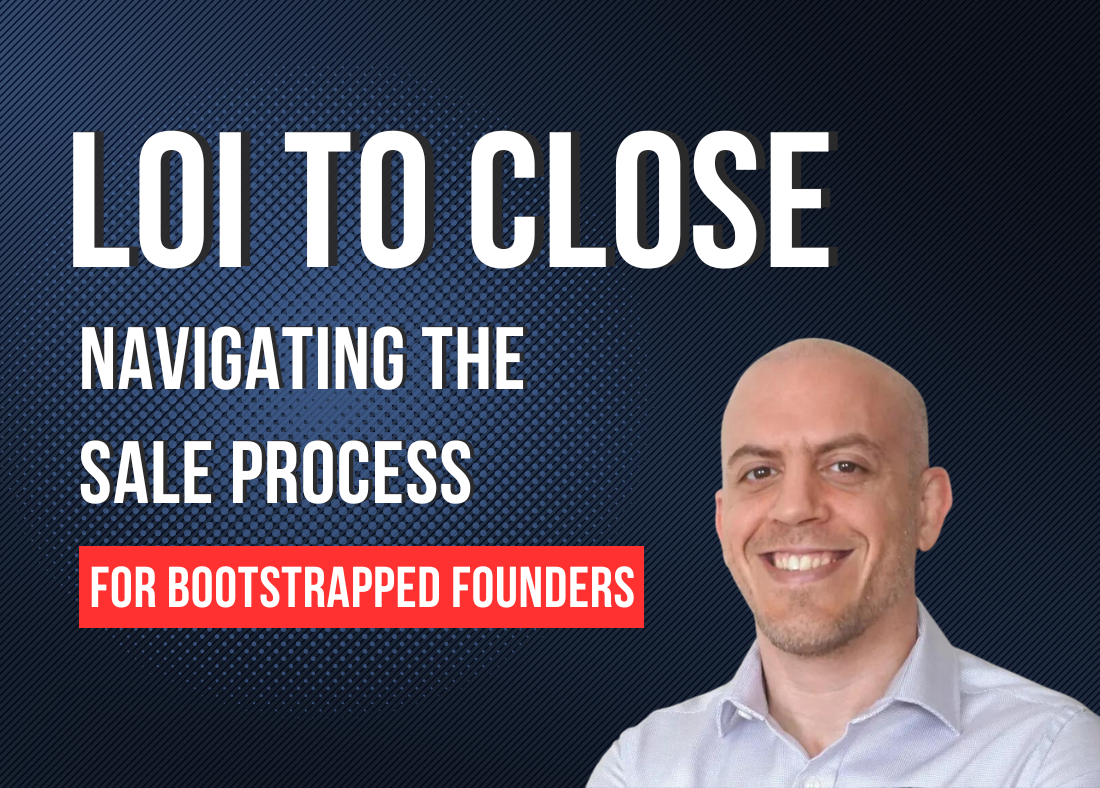In my previous article, I wrote about different types of acquirers for tech companies. This time, I want to talk about the actual sale process, from receiving initial interest, going through due-diligence and closing.
Should You Hire A Broker
An M&A broker is an individual or firm that provides advisory, sale-prep and access to potential acquirers. You can think of them as realtors for companies. Similarly to realtors, they take a percentage of the transaction – typically between 3.5%-5% though the range is wider than that.
One of the first important decisions you should make as you start considering a sale, is whether to engage a sell-side broker to help you navigate the process. Like any professional services, the quality and scope of the service can differ significantly.
In my case, I already had an existing relationship with our eventual broker, Discretion Capital, through a previous investment in our company. Before deciding on the engagement, I took a call with each member of the team to get a sense for the value they bring and how compatible we are personality wise.
Here’s a range of the services our broker performed for us –
- Providing advisory on our go-to-market strategy and timing.
- Helping us prepare the sale prospectus, known as a CIM, a massive marketing document that covers all the details prospective buyers would need to make an offer. This included preparing financial models and accounting statements, and crafting the narrative around the value of the company.
- Handling contacts and early negotiation with potential acquirers, then providing guidance on tended offers. Their in-depth knowledge of the process and negotiation skills increased the total value of the deal by about 30%.
- Provided due-diligence prep and support. The due-diligence process is a grueling multi-month in-depth look into the internals of the company and its future prospects. Their help here was invaluable.
- Helping us avoid potential pitfalls and stay prepared in case the deal falls apart during due-diligence.
- Though in our case it ended up not being needed, they also provide access to a large network of potential acquirers.
It’s definitely possible to sell your company without a broker, but a good broker can help you maximize the outcome of the deal, as well as increase the chances of it going smoothly by a significant margin.
My personal recommendation would be to use a broker, especially if it’s your first time going through this process.
The LOI – Letter of Intent
When engaging potential buyers for your business, the first step to formalizing that engagement is an offer letter called a Letter of Intent (LOI).
An LOI is very similar to a term sheet, and is typically used for M&A deals. The LOI is the official (though non-binding) offer an acquirer makes to acquire your company.
The LOI details the acquisition offer, from cash-in-hand, to equity rollup, to earn-outs and much more. Once you agree to the LOI, you typically enter a time limited exclusive contract with the acquirer, during which due diligence is performed.
Due to the cost and time investment of doing the due diligence, you want to make sure all of the major concerns regarding the offer are addressed before signing the LOI. It’s imperative that you have an experienced lawyer advising you through this process, as there are many potential pitfalls here that could really hurt you post sale.
Some important points that we had to make sure we hashed out in the LOI –
- My role post sale, and various protections to it
- The exact structure and timing of the acquisition (this can have major tax implications)
- Compensation structure – for example, the acquirer wanted some of the cash consideration to be paid out via a promissory note, which means I would technically loan them that amount and they pay it back over time (with interest). This kind of seller financing is quite common in M&A.
The back and forth through the lawyers took about 10 days, and we eventually hashed out the remaining points over the phone and moved to due diligence. Something to note here is that you should also have input and be willing to push back when needed – my lawyer was very protective of me (as they usually are), and was ready to negotiate every last point, but ultimately it was up to me to decide what is material, and where to compromise, in order to bring negotiations to conclusion.
Assuming you come to terms successfully, signing the LOI will lead to the next step – due diligence.
Going through due diligence
Due diligence is the process by which the potential acquirer obtains the information they need to make a buying decision on a business. The scope and internals of the due diligence process can vary wildly depending on the stage of your company, the deal size and the acquirer themselves.
In general, you can expect the acquirer to collect information about the following topics:
- Technology
- Accounting and tax
- Legal (Company structure, privacy, liability, IP, compliance)
- Financial performance and projections
- Team composition, history and plans
- Product overview and roadmap
- Marketing efforts and plans
- Background checks and references
Most of those were done via massive questionnaires and a data room that contained supporting documents we needed to provide. Depending on the scope of the due diligence and the size of the deal, the due diligence process can take anywhere from two weeks at the very low end, to 6+ months.
Our LOI limited the due-diligence process to 45 business days, which is relatively short, and we were able to complete it in 30, though we were still receiving some follow-up questions during the legal proceedings and closing.
Purchase Agreements
If the due-diligence goes smoothly, and the acquirer decides to move forward with the sale, they will send over the legal agreements formalizing the sale. This will include a purchase agreement detailing everything from the purchase consideration and terms, to a list of disclosures and warranties from the seller (you).
Other agreements would likely include a restated / new stockholder agreement for the company, an equity roll-up agreement (if you retain stock in the business), and potentially additional side-letters dealing with various matters brought up during due-diligence.
There’s a lot of technical terms to get familiar here, from NWC (Net Working Capital), to post-closing adjustments, representations and warranties, covenants, and more.
As before, a good lawyer guiding you and suggesting changes on your behalf is CRUCIAL. The agreements will be written from the viewpoint of the acquirer, and as such will try to maximize the control and protections they are provided with, sometimes at your expense. Your lawyer’s role is to make adjustments to make sure you are protected as well and to avoid potential pitfalls that can have significant implications in the future.
In my case, we also engaged a tax counsel to make sure we’re getting preferential tax treatment (long-term capital gains instead of regular income tax – which can have a massive impact on your final tax bill).
This step can also take from several weeks to several months depending on the complexity of the deal. In our case, it took as long as the due diligence phase, due to some additional complexities in the structure of the deal.
Something I learned from this process is that you can’t really relax once due-diligence is done. The purchase agreement phase is critical, and almost every word in the purchase agreements can have serious consequences down the line. I feel extremely lucky to having been introduced to an incredible corporate lawyer, who guided us with patience and experience throughout the process.
Closing
As the legal terms are nailed down, and the various agreements are finalized, eventually the day of finalizing the deal arrives. Wire instructions for the funds are collected, and signature pages are sent to all the involved parties.
The process of money flow is typically described in a document aptly called “Flow of funds”, that shows the pre-sale cap table, the various transfer of equity that would occur and sale amount for each. The seller’s transaction providers (broker, legal counsels, etc) are often paid directly from the sale proceeds, and described in the “Funds Flow” document.
You can expect issues to pop up until the last minute of closing – it did for us, and I’m told it’s just how it goes in M&A deals. From last minute changes to various elements of the purchase agreements, to additional diligence concerns that come up and need to be explored, you cannot let your guard down or assume that it’s a “done deal” until all signatures have been collected and wires have been sent.
The days that preceded the close were stressful, and filled with the above mentioned issues. At some point I developed insomnia as I was dealing with late night ominous emails that I felt I had to respond to to avoid delaying progress. We set deadlines for closing, and missed it multiple times. We got the deal finalized on a Friday, 30 minutes before the wire transfer deadline. It was nerve wrecking to the last minute.
Eventually all the issues are addressed, and the deal is closed. For me, and I believe many in the same position, it was more of a relief than a feeling of accomplishment. I have learned so much during the process, and if I had to do it again I believe it would have gone much more smoothly.
It’s a milestone that marks the end of a significant time in my life, building and growing my own company. I have given significant thought in the last two years to what I’ll be doing next – first, continuing on with the company and seeing it grow to the next level under the guidance of the acquirer, and second, supporting other founders going from 0 to profitable and an eventual sale.
If you are such a founder, you are welcome to reach out and talk, I’d be happy to listen, and share from my experience.




